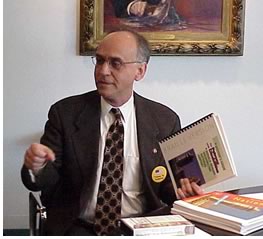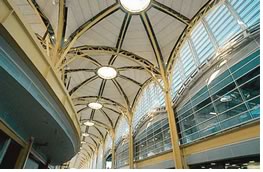
Daniel Feil, Staff Architect, Metropolitan Washington Airports Authority

Associate Editor
As part of a lecture series organized to educate AIA employees about the different ways architects practice, Daniel Feil, FAIA, staff architect for the Metropolitan Washington Airports Authority (MWAA) and terminal design project manager for the renovation of Ronald Reagan Washington National Airport, spoke to Institute staff October 10 about the role of the public architect as the client. Feil also spoke about the authority's collaboration with Cesar Pelli, FAIA, on the New Terminal at National Airport.
Who better to work
with than another architect?
It is, "an important thing to build for the public and to try to
create spaces that are appropriate for the public," Feil said during
his presentation. "[They should] speak about our culture and who
we are."
 He
said the best way to ensure that public buildings accomplish these goals
is to "have the people in charge of them—their design and construction—who
understand that . . . who better knows what architects can do than for
that process than another architect?"
He
said the best way to ensure that public buildings accomplish these goals
is to "have the people in charge of them—their design and construction—who
understand that . . . who better knows what architects can do than for
that process than another architect?"
A public architect throughout his career, Feil noted that to keep fresh and at the "top of their game," practitioners who work for the government or related agencies should be involved with a project at least every five years to understand evolving systems and practice methods, and to avoid being a "dull client."
Feil said he saw his job as two distinct parts: "To be the best client I know how [to be] for the contractors whom we hire, and to try to represent the needs and interests of my agency [in] the best way I know how."
"Architecture
speak"
Feil put these two contrasting—but not particularly conflicting roles—to
use as the authority worked with Cesar Pelli and his firm, Cesar Pelli
& Associates Inc., the design architect for the $450 million National
Airport terminal project. With the highly public and publicized project
came the need for an architect who would be able to provide high design,
and be up-to-the task of embracing the managerial role that comes with
such a multifaceted venture. Feil said Pelli's team demonstrated, throughout
the entire process, that it was ready for the challenge.
Pelli had never before designed an airport facility, but this did not prevent Feil and his team from selecting him for the project. Feil explained, "It's all about moving a lot of people in a very controlled way through big spaces." He convinced his management and the MWAA Board of Directors that teams that had done, for example, a large campus for a college or university, or a teaching hospital, would be able to apply that knowledge to the airport renovation. Pelli handled the project by first starting with the functional purpose and then derived the aesthetics of the building from that point forward.

Along the way, Feil said he combined his management and architectural experience to liaison with the prime and subcontractors involved in the process. They worked on a program for almost two years to define the needs of the terminal's users—the airlines, the public, the concessionaires, and many more—pulling them together and translating their needs to "architecture speak" to ensure that the design team understood the complex design issues.
He said, by the same token, he operated as a design critic, looking at the schemes and critiquing them. One nice thing about being the client, he noted, is simply having to state problems and concerns as they arise rather than having to propose solutions and fix them.
Feil praised Pelli, who took on the role of "master architect." In this role, Cesar Pelli and his firm contracted directly with the 30-some artists and artisans who conceived and executed the artworks for the new terminal, which are carefully integrated into the building's surfaces. A collaboration among artists on this level and scope had not been done more than 50 years.
 Pelli
asked for direct access to the client without necessarily going through
the prime contractor, so he had that written into his contract. He never
used that power, Feil noted, but just having it informed everyone of the
client's concern for design excellence. This allowed Pelli to become more
involved in the entire construction process. Working as the subcontractor
to the architect of record, Leo A Daly, Pelli had prime responsibility
for the design concepts, schematic designs, and design development, and
reviewed all construction documents to ensure the retention of design
intent.
Pelli
asked for direct access to the client without necessarily going through
the prime contractor, so he had that written into his contract. He never
used that power, Feil noted, but just having it informed everyone of the
client's concern for design excellence. This allowed Pelli to become more
involved in the entire construction process. Working as the subcontractor
to the architect of record, Leo A Daly, Pelli had prime responsibility
for the design concepts, schematic designs, and design development, and
reviewed all construction documents to ensure the retention of design
intent.
Pelli's firm impressed Feil with its production ethic, management skills, willingness and ability to document the project's progress, and its ability to meet deadlines, even when other parts of the project were stalled. "That's a huge responsibility for a sub to take on and try to pull off, and they did," Feil said. He also commended the firm for delivering about 500 drawings at the end of the design development phase and passing them off to Leo A` Daly. This package provided the solid basis for the construction phase of the project.
Lessons learned
"What the final product showed . . . is that if you give an architectural
team or an engineering team enough time and information, they can take
a building type—a complex one that they have never done before—and
do a great job."
On a separate note later on in the discussion, Feil said there were lessons to be learned from the experience of the retailers, specifically that it is important for national stores to look at their demographics and listen to the on-site personnel. For example, he cited one store that marketed exclusively to female shoppers even though about 60 percent of its patrons are male. He also said that the stores learned that they could have several locations in the airport and they didn't take business from one another. "The building doesn't work by someone walking from one end to the other," Feil said. So facilities did not lose customers, but actually gained new clientele when they opened additional outlets in different parts of the airport facility.
Copyright 2001 The American Institute of Architects. All rights reserved.
![]()
|
For more information about the 10-year design and construction of this work of public architecture at Reagan National Airport, click here. |
|